Ray Wilson authored this content while he was actively running MFOS as the founder and resident genius.
We retain the content because it reflects a valuable point of view representing that time and place.
Article by Ray Wilson
Features
Recommended Reading Before Starting This Project:
VCF Tuneup - or - Improving Filter Tracking
VCF Four Pole 24dB/Oct With VC Resonance Sample MP3sInput was two low frequency square waves. Slow Ramp CV No Resonance Slow Ramp CV Half Resonance Slow Ramp CV Full Resonance (Oscillation) Slow Ramp CV Full Resonance (No signal just oscillation) ADSR and LFO CV No Resonance ADSR and LFO CV Half Resonance ADSR and LFO CV Half Resonance (Slight Attack) ADSR and LFO CV Full Resonance (Oscillation) |
|
| Thomas White did an excellent job on his Low Pass filter. He even commented "I genuinely enjoy the filter." He made it feel right at home in his MOTM modular. | |
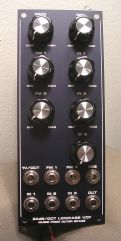
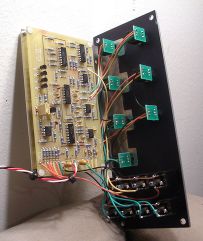
|
Introduction
Voltage Controlled Filters are, in my opinion, one of the coolest modules in any synthesizer. They can subtract or add harmonics from the original signal and dynamically change the harmonic content as they are swept by external control voltages or track the keyboard voltage used to control your oscillators. I love the sound of a couple of oscillators tuned low and close to unison put through a low pass filter with a fair amount of resonance. As you modulate the cut off frequency (also in the low range) it has the sound of an airplane passing overhead or a hoomy singer modulating the frequency content of their droning chant by formant filtering with the mouth and throat. And of course white noise through a slowly modulated resonant filter sounds like you're out on the frozen tundra. This filter includes voltage controllable cut off frequency and resonance (or Q) that gives you more variables to play with as you experiment with sounds from your imagination. Additionally it provides inputs for a three-signal mixer.
Suggested Improvements
While investigating an issue that a filter builder asked about I decided to rebuild one of the filters in my modular. I had used a hand etched board and had made a daughter board for the mixer section as well. I replaced it with one of the boards I sell and as usual I came up with some "suggestions for improvement" which I share here. Now bear in mind that variations in components and chips (LM13700 primarily) may cause you to use slightly different values. DIY is all about experimentation. With the changes I made related to tracking improvements I was able to get the filter to track 6 or more octaves in sine oscillator mode (resonance all the way up). If you are happy with the performance of your filter as usual... leave well enough alone.. When I applied my VPO calibrator voltage I could not adjust the V/Oct trimmer to get the octaves I wanted to hear. I set the V/Oct trimmer to mid-point and then placed a variable resistor in parallel with R12 and adjusted it until the parallel combination of the two put me in the range I was looking for (I was getting rough octaves now). The effect was to reduce the gain of the inverting control voltage summer. I measured the resistance and soldered the resistor with the closest standard value (7.5K) in parallel with R12. Then I found I could trim nicely but the high frequency compensation was not having enough effect (I was going flat on higher octaves). So I used the same technique (variable resistor in parallel with R2) until the high frequency compensation was on the money. Again found the closest standard value (68K) and soldered it parallel with R2. After that I was able to trim it in with excellent precision. The matched transistors (NPNs Q1 to Q2 and PNPs Q to Q4 to Q5 to Q6) were also an important improvement. Although it would be nice to live in a world where you put a circuit together and it works flawlessly, far more typically you have to do some tweaking like this to get things where you want them. One last thing. You can overdrive the filter by setting the input levels too high and I found that the first indication of overdriving is reduction of resonance so... experiment with the levels of the input mixer so you know how the filter reacts to the levels of the inputs you are applying. Overdriving the filter will not hurt it, it just changes it's filtering characteristics while being overdriven. I hope you benefit from this info.
Improved the range of the "Cut Off Frequency" control
- Replaced R1 (33K resistor) with a wire jumper.
- Replaced R6 (39K resistor) with a 75K resistor.
Improved tracking (your mileage may vary)
- Use matched 2N3904 NPN pair for Q1, Q2 to within 2mV Vbe.
- Match all 2N3906 PNP Q3, Q4, Q5, and Q6 to within 2mV Vbe.
- Placed a 7.5K resistor in parallel with R12 (2K resistor).
- Placed a 68K resistor in parallel with R2 (47K resistor).
Increase the mixer gain
- Replace R43 (390K resistor) with 1M resistor.
- OR
- Replace R34, R37, and R42 (1M resistor) with 200K resistors.
VCF 24dB/Oct With VC Resonance Schematic Page 1 (SUGGESTED IMPROVEMENTS)

VCF 24dB/Oct With VC Resonance Schematic Page 1 (ORIGINAL) PDF

|
Up to 3 signal inputs can be applied to circuit points AIN1 thru AIN3. The .1uF input caps into 1 meg input resistors reduces the high pass effect that a smaller input resistor would have since pin 2 of U5-A is a virtual ground. Square waves of relatively low frequency will not differentiate too badly thus preserving their low frequency content. Signal levels of +/-5V are expected. If you have higher signal levels then reduce the value of R43 to insure that U5-A is not clipping when you feed in your signals. The opposite would be true as well (lower levels increase value of R43 to get adequate signal to noise ratio). U5-A acts as an active mixer with a gain of .39 (with values shown). The output of U5-A is fed into the filter via R22. The suggested panel layout shows jacks and three pots used as adjustable voltage dividers (level controls) to provide an input mixer for the unit. The jacks and mixer pots are not shown on the schematic. This VCF uses LM13700 transconductance amplifiers as voltage-controlled integrators. There are four of them in a chain and they operate in the same way. U2-B's transconductance is controlled by current flowing through R18 to Q3 to ground. It acts like a voltage-controlled resistor that in conjunction with C2 is an RC filter. Since the output of U2-B is a current the signal is actually integrated onto C2. The filtered (actually integrated) signal is buffered by U4-B and fed to the next stage (a portion is also fed back to the input of U2-B via R26). R14 is used to bias the LM13700 linearizing diodes on (which is advertised to reduce distortion through the amp). R52 compensates for the positive offset applied via R14 (yes it goes to -12 but its applied to the inverting input). The goal is to keep the signal path of the system as close to operating about ground as possible. In practice you will see as high as +/-200 to +/-300 mV of offset at any of U4's outputs but that's fine. If things were operating near the rails we would have a problem. The output is finally capacitively coupled to the output so the output signal operates precisely about ground. Each filter section contributes 6dB/octave filtering (thus the four together result in 24dB/octave). The cut-off frequency control voltage inputs (CV1, CV2 and CV3) are applied to U1-A via the 100K input resistors R7, R10, and R11. Control voltage of between -5V and +10V are expected. Initial Cutoff Frequency control (R3) is used to set the initial cut-off frequency. R1 and R6 limit the range of voltage available at the wiper of R3 in the extreme positions. The summed control voltages are inverted by U1-A (inverting amp gain of .02) and fed to trimmer R5. The 20mV per volt output from U1-A can be trimmed to the requisite 18mV/volt by R5 that drives logging transistor Q1 to achieve a 1V/oct response in filter cut-off frequency. Current through Q1 is mirrored by Q2 that controls the current flowing from collector to emitter in Q3, Q4, Q5, and Q6. These transistors (Q3, Q4, Q5, and Q6) control the current flowing from the "amp bias input" pins of the LM13700s to ground via current limiting resistors (R18, R19, R20, and R21). The result is that all four integrators are controlled simultaneously. Since all four of them are tuned to the same cut-off frequency very little signal above the cut-off frequency gets through. This is a very effective filtering technique. The output of the last integrator (U4-A pin 1) is fed via C7 to U5-B (non-inverting gain of 2) amplifier that acts as the output buffer. R39 couples U5-B pin 1's output to FOUT the filter output.
|
VCF 24dB/Oct With VC Resonance Schematic Page 2 PDF
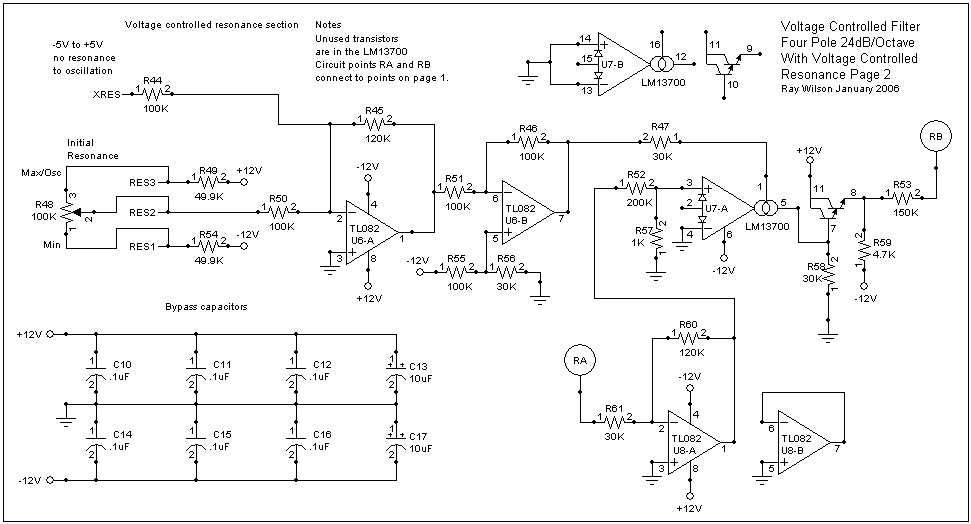
Point RA pg.1 (U5-B pin 7) connects to corresponding point RA pg.2 (R61 pin 1) that is the input to gain of 4 inverting amplifier U8-A. U8-A's output is fed into U7-A (LM13700 transconductance amp) that controls the amount of negative feedback applied to the input of the filter (point RB pg.2 connects to corresponding point RB pg.1). Adding negative feedback results in the characteristic low-pass filter ringing that adds interesting harmonics to the original signal. You will also notice that the output signal level will decrease as the feedback is increased. Simultaneously the amplitude of the ringing will increase. This control is referred to as resonance because the harmonic content of the original signal is accentuated when the control is advanced. At maximum feedback the circuit will produce a very pure sine wave that can be used as a pitch source or control voltage. When the resonance is at about mid level and noise is used as the input signal the output will produce pitched noise. The resonance control circuit simply applies from ground to -10 volts to R47 that controls the "amp bias input" of U7-A and thus its transconductance linearly. The resonance control signal XRES is expected to be -5V to +5 volts.
| Approx. Current Consumption | |
| +12V | 32mA |
| -12V | 32mA |
| +15V | 40mA |
| -15V | 45mA |
You can use just about any general purpose BIFET opamp for the TL084 (quad) and TL082 (dual) and you can sub any of these (LM13600, NE5517, AU5517, NTE870) for the LM13700. General purpose NPNs can be used for Q1 and Q2 and their PNP counterparts should be used for the PNPs.
As usual I must disclaim any credit regarding the invention of these concepts. The Robert Moogs and Bernie Hutchins of the world figured all of these concepts out. I am merely implementing my version of it. Acknowledgements Page
VCF 24dB/Oct With VC Resonance PCB Parts Layout (Parts Side Shown) PDF
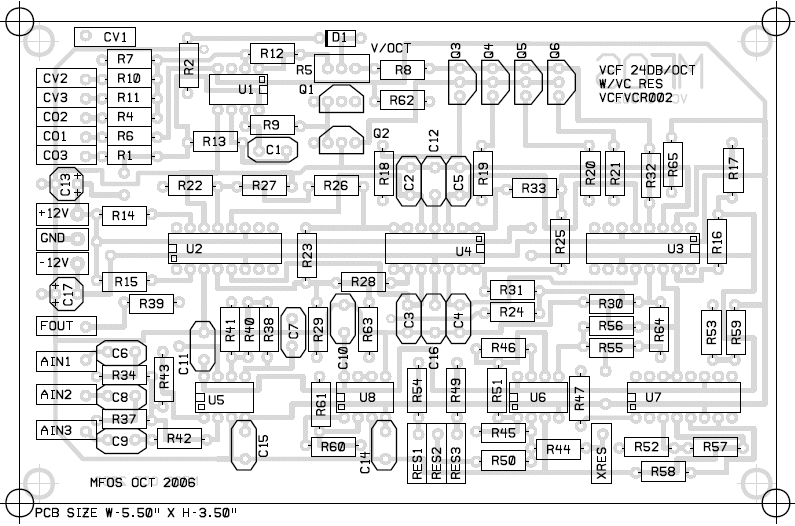
VCF 24dB/Oct With VC Resonance PCB Parts Values (Parts Side Shown) PDF
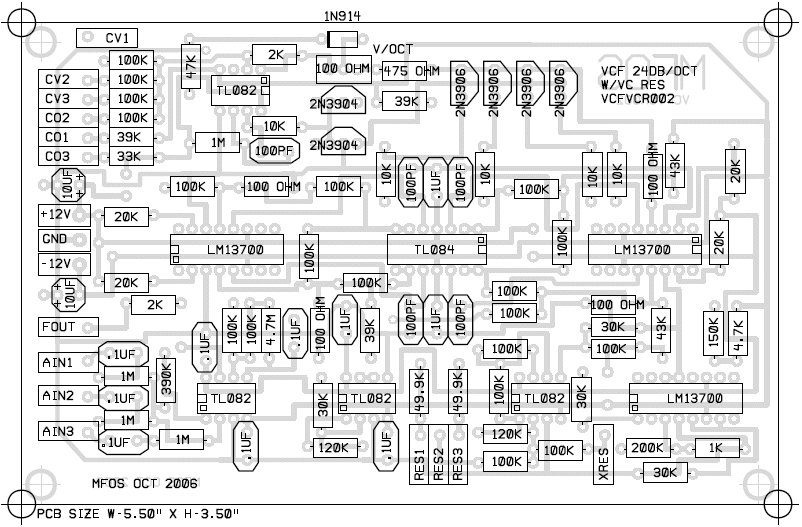
PCB Layouts
VCF 24dB/Oct With VC Resonance PCB Bottom Copper (Parts Side Shown)
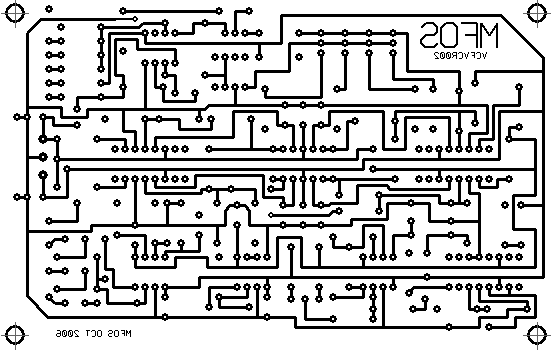
VCF 24dB/Oct With VC Resonance PCB Top Copper(Parts Side Shown)
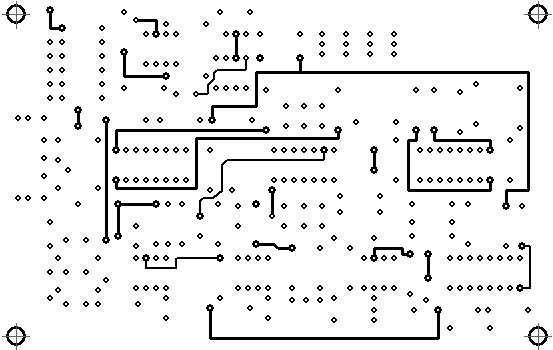
VCF 24dB/Oct With VC Resonance PCB Top Silk Screen
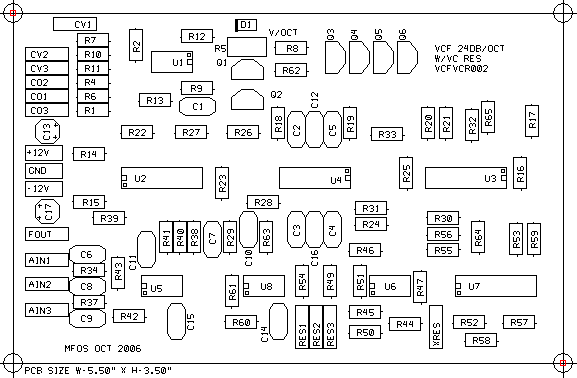
Panel Wiring
VCF 24dB/Oct With VC Resonance Front Panel and Wiring PDF
The jacks and mixer pots shown in this suggested layout are not on the schematic. Use whatever jacks you are using in your system. The suggested mixer pots are 100K linear taper (log taper would also work fine). This suggestion is provided merely as an example or wiring guide.
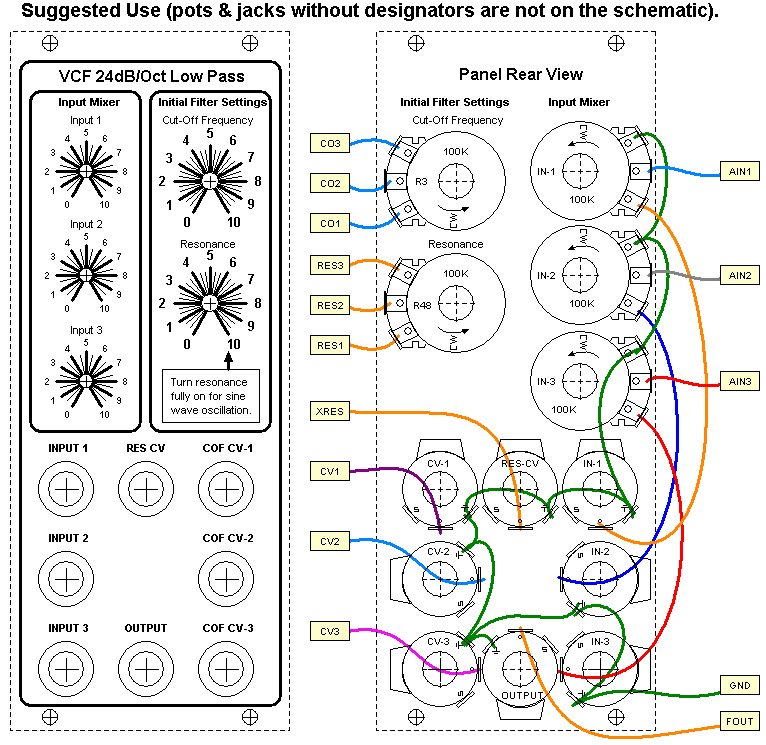
VCF 24dB/Oct With VC Resonance Calibration
This filter can be calibrated to allow it to track 1V/octave over several octaves. You can get adequate tracking performance with non-matched transistors and a normal resistor for R12 however for best tracking performance (over the maxmimum number of octaves) I suggest the following. Match Q1 and Q2 (2N3904 NPN) to within 2mV for the VBE parameter. Match Q3, Q4, Q5, and Q6 (2N3906 PNP) to within 2mV for the VBE parameter. Use a 2K 1% or 2% +3300 ppm tempco for U1-A feedback resistor. Use 1% metal film resistors for all of the resistors in the control voltage summer and log convertor. Also the caps used for each filter stage C2, C3, C4, C5 should be polystyrene or silver mica for best temperature compensation and cap to cap matching.
Calibration Procedure
- Remove all inputs (signal and control voltage) from the filter.
- Connect one source of test voltage (set to 0.000 volts) to one of the CV inputs.
- Connect the output of the filter to a frequency counter (you ears and an amp can also do).
- Adjust R5 until it is at the center position. This is done by turning your pot until you hear the end of range clicks and then turning it the opposite way while counting turns until you hear the oppposite end of range clicks. Now turn it back half of the turns you just counted.
- Turn the filter's cut off frequency control to about 8 o'clock.
- Turn the filter's resonance control up until the filter sustains oscillation over the full rotation of the cut off frequency knob.
- Leave the resonance control set to this level for the rest of the procedure.
- Adjust the cut off frequency so that the filter is oscillating at 100.0 hertz.
- Increase the test voltage fed to the CV input to 3.000 volts.
- Adjust R5 until the frequency changes to 800.0 hertz.
- Continue to set the voltage back to 0 (reset the frequency to 100.0 Hz.) and up to 3 while adjusting R5 until you get the best scaling.
- The best scaling is when each change in 1V between 0V and 3V causes a doubling (octave change) in frequency.
- R2 may be replaced with a 100K trimmer to allow additional adjustment of the high frequency compensation if necessary.
- Continue applying higher voltage to the CV and adjusting R5 as necessary to get the best scaling over the widest range.
VCF 24dB/Oct With VC Resonance Project Parts List
I specify all resistors as 1% but 5% will work. Metal film 1% will give you better temperature stability. Capacitors can be film, ceramic, or silver mica. The 100pF integrator caps should be high quality and well matched for best results. You can use just about any general purpose BIFET opamp for the TL084 (quad) and TL082 (dual) and you can sub any of these (LM13600, NE5517, AU5517, NTE870) for the LM13700.
| Qty. | Description | Value | Designators |
|---|---|---|---|
| 3 | LM13700 Dual gm OpAmp(s) | LM13700 | U2, U3, U7 |
| 4 | TL082 Dual Op Amp(s) | TL082 | U1, U5, U6, U8 |
| 1 | TL084 Quad Op Amp | TL084 | U4 |
| 1 | 1N914 Sw. Diode | 1N914 | D1 |
| 2 | 2N3904 NPN Transistor | 2N3904 | Q1, Q2 |
| 4 | 2N3906 PNP Transistor | 2N3906 | Q4, Q6, Q5, Q3 |
| 10 | Ceramic or Film Capacitors | .1uF | C9, C8, C6, C7, C10, C14, C11, C15, C16, C12 |
| 5 | Ceramic or Film Capacitors | 100pF | C4, C5, C3, C1, C2 |
| 2 | Tantalum Capacitors | 10uF @35V | C13, C17 |
| 5 | Linear Taper Potentiometer(s) | 100K | R3, R48 & Mixer Pots |
| 1 | Cermet Trim Pot | 100 ohm | R5 |
| 2 | Resistor 1/4 Watt 1%(s) | 49.9K | R54, R49 |
| 19 | Resistor 1/4 Watt 1%(s) | 100K | R22, R24, R25, R33, R23, R41, R40, R31, R7, R11, R10, R4, R26, R28, R50, R46, R55, R51, R44 |
| 5 | Resistor 1/4 Watt 1%(s) | 10K | R18, R19, R20, R21, R9 |
| 2 | Resistor 1/4 Watt 1%(s) | 120K | R60, R45 |
| 1 | Resistor 1/4 Watt 1% | 150K | R53 |
| 1 | Resistor 1/4 Watt 1%(s) | 1K | R57 |
| 4 | Resistor 1/4 Watt 1%(s) | 100 ohms | R29, R27, R30, R32 |
| 4 | Resistor 1/4 Watt 1%(s) | 1M | R42, R34, R37, R13 |
| 1 | Resistor 1/4 Watt 1% | 200K | R52 |
| 4 | Resistor 1/4 Watt 1%(s) | 20K | R14, R15, R16, R17 |
| 2 | Resistor 1/4 Watt 1%(s) | 2K | R12, R39 |
| 4 | Resistor 1/4 Watt 1%(s) | 30K | R58, R47, R56, R61 |
| 1 | Resistor 1/4 Watt 1% | 33K | R1 |
| 1 | Resistor 1/4 Watt 1% | 390K | R43 |
| 3 | Resistor 1/4 Watt 1%(s) | 39K | R6, R62, R63 |
| 1 | Resistor 1/4 Watt 1% | 4.7K | R59 |
| 1 | Resistor 1/4 Watt 1% | 4.7M | R38 |
| 2 | Resistor 1/4 Watt 1%(s) | 43K | R64, R65 |
| 1 | Resistor 1/4 Watt 1% | 475 ohm | R8 |
| 1 | Resistor 1/4 Watt 1% | 47K | R2 |
| 8 | 1/4" Phone Jacks | Phone Jack | Panel Jacks |
Miscellaneous
- (1) 1/16" Thick aluminum plate for mounting the pots and switches.
- Unit is typically mounted in a synth case with other synth modules.
- Assorted hardware 1" 6-32 nuts and bolts, 1/2" #8 wood screws, etc
- Knobs for potentiometers, wire, solder and typical assorted electronics hand tools.
- Digital Volt Meter and a Signal Tracer or oscilloscope for testing.